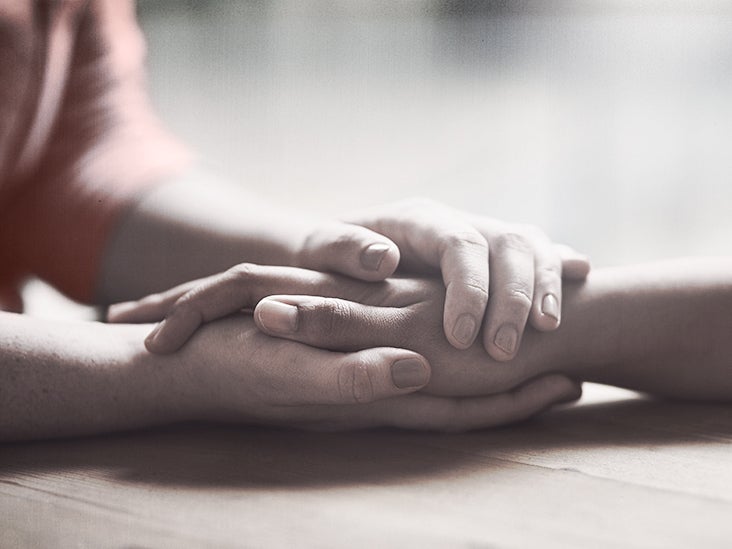
Self-inflicted injury is the act of intentionally harming one’s own body without meaning for the injury to be fatal. People who engage in self-inflicted injury typically do so in an attempt to cope with distress, anger, and other painful emotions.
While self-inflicted injury may help people to cope with difficult feelings temporarily, it can cause emotional and physical harm long term. The practice may also have unintended consequences, such as severe injury or accidental death.
With support and treatment, people can reduce their distress and find healthier ways to manage emotions and cope with painful experiences.
Suicide prevention
If you know someone at immediate risk of self-harm, suicide, or hurting another person:
- Ask the tough question: “Are you considering suicide?”
- Listen to the person without judgment.
- Call 911 or the local emergency number, or text TALK to 741741 to communicate with a trained crisis counselor.
- Stay with the person until professional help arrives.
- Try to remove any weapons, medications, or other potentially harmful objects.
If you or someone you know is having thoughts of suicide, a prevention hotline can help. The National Suicide Prevention Lifeline is available 24 hours per day at 800-273-8255. During a crisis, people who are hard of hearing can call 800-799-4889.
A self-inflicted injury is an injury that a person gives themselves on purpose, without the intent to end their life. Other names for this behavior include self-harm, self-mutation, nonsuicidal self-injury (NSSI), and parasuicidal behavior.
People who self-harm most commonly injure their arms, legs, or torso because these areas are easiest to reach and to hide under clothing. Some people also injure their scalp, as they can hide wounds under their hair or a hat.
According to Mental Health America, the most common methods of NSSI are:
- skin cutting, which accounts for 70–90% of self-injuries
- head banging or hitting, which accounts for 21–44%
- burning, which accounts for 15–35%
Most people who self-injure use more than one method. Other forms of harm that can be self-inflicted include:
- hair pulling
- scratching or picking the skin
- interfering with healing wounds
- inserting objects into body openings
- punching objects, causing injuries to the hands
- hitting oneself with fists or objects
- intentional exposure to an infection or toxin
- jumping off high walls or buildings
- drinking harmful liquids, such as detergent
- taking harmful substances, or high doses of a substance
People who engage in self-injury typically do so as a coping mechanism. Coping mechanisms are behaviors people use to manage difficult feelings, such as fear, anger, or sadness.
It can be difficult for others to understand how feeling physical pain could help a person feel temporary relief from emotional pain. But to the person who has self-harmed, it could seem like the only way to cope. People might self-injure to:
- express the pain they are feeling, particularly if they struggle or are unable to do this through words
- communicate distress to others in an indirect way
- distract themselves from painful emotions or memories
- feel like they have control over some aspect of their lives
- feel something other than “numbness,” disconnection, or dissociation
- punish themselves for their emotions or perceived failures
While some types of coping mechanism can be helpful, self-injury is a maladaptive coping mechanism. This means that while it may offer some temporary benefit, it causes mental and physical harm in the long term.
Self-injury can also become a compulsion. Some people only self-injure a few times, but for others, it can become a long-term behavior that is difficult to stop. For these individuals, the more they self-injure, the more they feel compelled to keep doing it.
Anyone can engage in self-inflicted injury. But some groups are more at risk than others. These include:
Teenagers and young adults
Self-harm is more common among teenagers and young adults than other age groups. Mental Health America reports that self-injury occurs in approximately 15% of teens, 17–35% of college students, and up to 4% of adults in the United States.
A 2017 review identified that the most common age of onset for self-injury in young adults was between 12–14 years of age.
The reasons for this are complex. Young people may struggle with feeling misunderstood, isolated, or rejected by their peers. They may also experience bullying, academic pressure, and other events that they find difficult to talk about.
People who are LGB
Young people who belong to a sexual minority, such as those who are lesbian, gay, or bisexual (LGB), are also more likely to self-harm than those who are heterosexual.
According to the
Learn more about how heterosexism and homophobia affect health.
People with mental health conditions
Self-harm can be an outward sign of a mental health condition. It can be a manifestation of self-loathing, or a way of coping with intense feelings caused by the condition.
People with any type of mental health condition can self-harm, but those that cause obsessive thoughts or compulsive behavior are particularly associated with it. This can include:
Self-injury can also be a response to past trauma. Traumatic experiences such as sexual abuse, domestic violence, or chronic stress can cause a range of intense emotions. In some cases, it can lead to post-traumatic stress disorder.
It can be difficult for friends and family to see the warning signs of self-inflicted injury, as many people hide their injuries from others.
Some signs to look out for include a person:
- always covering their arms and legs, even in warm weather
- having unexplained scars
- having frequent unexplained injuries, such as cuts, bruises, burns, bite marks, or broken bones
- becoming withdrawn and avoiding social interaction
- eating more or less than normal
- having new or worsening difficulties at school, work, or in their relationships
- having difficulty managing their feelings, or seeming extremely sad or angry
- expressing low self-esteem, self-loathing, or a desire to punish oneself
- developing another mental health condition, such as a substance abuse or eating disorder
It is possible to stop self-harming. The first step in doing this is admitting that self-harm is occurring, and that it is damaging rather than helpful.
Once a person does this, they can start to replace self-harm with other coping mechanisms. When the urge to self-harm arises, try:
Reaching out for help
Talk to a trusted friend or adult about feelings or experiences that are causing pain. If talking to a friend or family member is not possible, try speaking with a school nurse, teacher, doctor, or counselor.
This can be a difficult step. If speaking in person feels daunting, try writing an email or a letter instead.
Not everyone is knowledgeable about self-harm or how best to approach it, so if the first attempt at getting support does not go as planned, try speaking to someone else.
Seeking professional support
Even if someone has a trusted friend or adult they can talk to, it is always beneficial to seek help and resources from professionals.
S.A.F.E. Alternatives (Self-Abuse Finally Ends) has an information line available at 1-800-DONT-CUT or 1-800-366-8288. Their website is www.selfinjury.com.
If a person is having thoughts of serious self-harm or suicide, call the National Suicide Prevention Lifeline at 800-273-8255. People who are hard of hearing can call 800-799-4889.
Removing any self-harm equipment
Those who self-harm by using sharp objects, hazardous liquids, or other items should remove them from reach. If possible, ask someone else to store them securely.
Practicing distraction techniques
Distraction can be an effective way to avoid self-harm until the urge to do it passes. Examples include:
- calling a friend
- going for a walk, a run, or doing another form of exercise
- doing something creative, such as drawing or writing
- playing with an animal
- watching comforting TV shows or movies
People may need to try several techniques to find one that works. Make a list of distraction techniques to turn to when needed.
Releasing pent-up feelings
When feeling painful emotions, try alternative ways to express or release them. This could include:
- crying
- screaming or shouting into a pillow
- punching a pillow
- scribbling on or ripping up paper
- “venting” feelings by writing them down or talking to someone
Finding temporary substitutes
Some people find it helpful to try temporary and safe substitutes for their usual method of self-harm. This can be helpful if other methods of managing emotions are not possible, or if they are not helping.
Some substitutes people use include:
- gently snapping an elastic band on the wrist
- rubbing an ice cube on the skin
- drawing on the skin where a person would typically cut
This approach does not tackle the cause of self-harm or help a person heal in the long term. To fully recover, treatment from a therapist is often necessary.
Support from both healthcare professionals and loved ones is an important part of recovery for people who self-harm. If a person thinks someone they know could be self-injuring, they can:
- Address immediate medical concerns: The priority when supporting a person who has injured themselves is to reduce or prevent harm. If they have a serious injury, have swallowed poison, or have experienced significant blood loss, call 911 or go to the emergency room. If they are an immediate danger to themselves, it may also be necessary to call emergency services.
- Show love and support: It is natural to feel upset if someone has harmed themselves, but being angry or blaming them may increase feelings of guilt and shame. Remember that the person who has self-harmed is already in a lot of pain. Try to look past the behavior and instead focus on the person.
- Listen to them: Give the person space to talk about their feelings and experiences, but do not rush them. When they are ready to talk, acknowledge that their feelings and experiences are valid.
- Address the role of self-harm: Avoiding talking about self-injury can reinforce stigma. Instead, acknowledge that self-harm may have helped the person deal with a difficult time, but that there are other, healthier coping mechanisms.
- Help make a plan: If a person wants to stop self-harming but does not know how else to cope with their feelings, people can help them to think of a list of alternative methods for dealing with intense emotions.
- Encourage them to see a mental health professional: Therapy can give people the space to talk about their feelings and learn to manage them in a safe environment. If the person wants to see a therapist but feels nervous, others can help by making appointments, providing transport, or accompanying them to sessions.
- Be patient: Often, the behavior may not stop immediately. It can take time to learn other ways of managing emotions.
It is worth noting that friends and family can also need support when a loved one is self-harming.
Treatment for self-inflicted injury will vary from one person to another. For most people, it will include a combination of:
- psychotherapy
- medication to reduce distressing symptoms, such as racing thoughts
- treatment for co-occurring conditions, such as an eating disorder
How a person receives treatment can depend on the severity of their symptoms, and how seriously they injure themselves.
In cases of severe or repetitive self-injury, a person may require a stay in a psychiatric hospital. Alternatively, a person may enroll in a day-treatment program, where they remain in medical care during the day and return home in the evening.
Others may benefit from outpatient therapy, which does not involve staying in a healthcare center.
There are many types of therapy, but typically, they help people:
- identify the reasons for self-harm
- process difficult events and emotions
- learn new coping skills
- learn to manage emotions in a healthy way
By definition, self-inflicted injury is not a suicide attempt. But
A 2013 study reports that students who self-injured at the beginning of the study who did not report suicidal thoughts, but who subsequently engaged in 20 or more self-injuring behaviors, were 3.4 times more likely to attempt suicide by the end of the study 3 years later.
According to Mental Health America, this may occur as a result of people feeling their behavior is out of control or wanting to stop, resulting in suicide attempts. Accidental death is also a risk.
For this reason, it is important for individuals who struggle with self-harm to seek help.
Learn more about suicide, its warning signs, and how to help prevent it.
Self-inflicted injury is a coping mechanism that can occur for a variety of reasons. Often, it is the result of difficult emotions or experiences.
With support from loved ones and help from health professionals, people who self-injure can learn healthier coping techniques and recover from self-harming behaviors.
Speaking to a loved one, doctor, or mental health professional is the first step in the recovery process.








